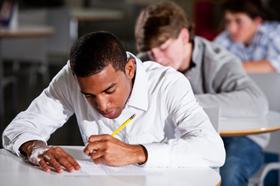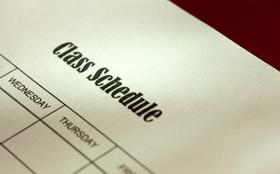Top Rankings
New York City Geographic District #14 School District ranks among the top 20% of public school district in New York for:
Category
Attribute
Diversity
Most diverse schools (Top 1%)
Community Size
Largest student body (number of students) (Top 1%)
For the 2025 school year, there are 13 public high schools serving 6,201 students in New York City Geographic District #14 School District. This district's average high testing ranking is 5/10, which is in the bottom 50% of public high schools in New York.
Public High Schools in New York City Geographic District #14 School District have an average math proficiency score of 66% (versus the New York public high school average of 67%), and reading proficiency score of 61% (versus the 59% statewide average).
Public High School in New York City Geographic District #14 School District have a Graduation Rate of 86%, which is less than the New York average of 88%.
The school with highest graduation rate is Brooklyn Latin School, with ≥95% graduation rate. Read more about public school graduation rate statistics in New York or national school graduation rate statistics.
Minority enrollment is 95% of the student body (majority Hispanic), which is more than the New York public high school average of 61% (majority Hispanic).
Overview
This School District
This State (NY)
# Schools
38 Schools
1,462 Schools
# Students
15,154 Students
948,443 Students
# Teachers
1,279 Teachers
85,120 Teachers
Student : Teacher Ratio
12:1
12:1
Student By Grade
District Rank
New York City Geographic District #14 School District, which is ranked #509 of all 1,015 school districts in New York (based off of combined math and reading proficiency testing data) for the 2022-2023 school year.
The school district's graduation rate of 82% has increased from 80% over five school years.
Overall District Rank
#521 out of 1020 school districts
(Bottom 50%)
(Bottom 50%)
Math Test Scores (% Proficient)
(22-23)47%
52%
Reading/Language Arts Test Scores (% Proficient)
50%
49%
Science Test Scores (% Proficient)
77%
78%
Graduation Rate
(22-23)82%
87%
Students by Ethnicity:
Diversity Score
0.64
0.72
% American Indian
n/a
1%
% Asian
5%
9%
% Hispanic
55%
30%
% Black
20%
18%
% White
16%
39%
% Hawaiian
n/a
n/a
% Two or more races
4%
3%
All Ethnic Groups
Best New York City Geographic District #14 School District Public High Schools (2025)
School
(Math and Reading Proficiency)
(Math and Reading Proficiency)
Location
Grades
Students
Rank: #11.
Williamsburg High School For Architecture And Design
Vocational School
(Math: ≥95% | Reading: 85-89%)
Rank:
Rank:
10/
Top 5%10
257 N 6th St
Brooklyn, NY 11211
(718) 388-1260
Brooklyn, NY 11211
(718) 388-1260
Grades: 9-12
| 614 students
Rank: #22.
Brooklyn Preparatory High School
(Math: 85-89% | Reading: 90-94%)
Rank:
Rank:
10/
Top 5%10
257 N 6th St
Brooklyn, NY 11211
(718) 486-2550
Brooklyn, NY 11211
(718) 486-2550
Grades: 9-12
| 567 students
Rank: #33.
Williamsburg Preparatory School
(Math: 80-84% | Reading: 90-94%)
Rank:
Rank:
10/
Top 10%10
257 N 6th St
Brooklyn, NY 11211
(718) 302-2306
Brooklyn, NY 11211
(718) 302-2306
Grades: 9-12
| 679 students
Rank: #44.
Brooklyn Latin School
(Math: ≥99% | Reading: ≥50%)
Rank:
Rank:
9/
Top 20%10
223 Graham Ave
Brooklyn, NY 11206
(718) 366-0154
Brooklyn, NY 11206
(718) 366-0154
Grades: 9-12
| 733 students
Rank: #55.
Williamsburg High School Of Art And Technology
Magnet School
(Math: 60-64% | Reading: 60-64%)
Rank:
Rank:
8/
Top 30%10
223 Graham Ave
Brooklyn, NY 11206
(718) 599-1207
Brooklyn, NY 11206
(718) 599-1207
Grades: 9-12
| 422 students
Rank: #66.
A-tech High School
Vocational School
(Math: 55-59% | Reading: 55-59%)
Rank:
Rank:
7/
Top 50%10
50 Bedford Ave
Brooklyn, NY 11222
(718) 218-9301
Brooklyn, NY 11222
(718) 218-9301
Grades: 9-12
| 459 students
Rank: #77.
Young Women's Leadership School Of Brooklyn
(Math: 40-44% | Reading: 65-69%)
Rank:
Rank:
7/
Top 50%10
325 Bushwick Ave
Brooklyn, NY 11206
(718) 387-5641
Brooklyn, NY 11206
(718) 387-5641
Grades: 6-12
| 261 students
Rank: #88.
El Puente Academy For Peace And Justice
(Math: <50% | Reading: 80-89% )
Rank:
Rank:
7/
Top 50%10
250 Hooper St
Brooklyn, NY 11211
(718) 387-1125
Brooklyn, NY 11211
(718) 387-1125
Grades: 9-12
| 176 students
Rank: #99.
Progress High School For Professional Careers
(Math: 55-59% | Reading: 40-59%)
Rank:
Rank:
7/
Top 50%10
850 Grand St
Brooklyn, NY 11211
(718) 387-0228
Brooklyn, NY 11211
(718) 387-0228
Grades: 9-12
| 398 students
Rank: #1010.
East Williamsburg Scholars Academy
(Math: 60-69% | Reading: 21-39%)
Rank:
Rank:
5/
Bottom 50%10
850 Grand St
Brooklyn, NY 11211
(718) 387-2800
Brooklyn, NY 11211
(718) 387-2800
Grades: 9-12
| 492 students
Rank: #1111.
High School For Enterprise Business & Technology
(Math: 65-69% | Reading: 20-29%)
Rank:
Rank:
5/
Bottom 50%10
850 Grand St
Brooklyn, NY 11211
(718) 387-2800
Brooklyn, NY 11211
(718) 387-2800
Grades: 9-12
| 542 students
Rank: #1212.
Lyons Community School
(Math: ≤10% | Reading: 40-44%)
Rank:
Rank:
2/
Bottom 50%10
223 Graham Ave
Brooklyn, NY 11206
(718) 782-0918
Brooklyn, NY 11206
(718) 782-0918
Grades: 6-12
| 384 students
Rank: #1313.
Juan Morel Campos Secondary School
(Math: 20-24% | Reading: 25-29%)
Rank:
Rank:
2/
Bottom 50%10
215 Heyward St
Brooklyn, NY 11206
(718) 302-7900
Brooklyn, NY 11206
(718) 302-7900
Grades: 6-12
| 474 students
Recent Articles

The Link Between Education and Incarceration: The NAACP Report
Education and the rate of incarceration have been linked in a recent NAACP report. Learn about the report and the troubling findings.

The Debate Over Mandatory AP Exams: Balancing Academic Rigor and Student Well-being
Some public schools are forcing students in AP courses to take the AP exam. Here's a look at both sides of the debate and the potential benefits in store for both students and high schools.

The 15 Biggest Failures of the American Public Education System
The world is in a constant state of change and those who fail to adjust fall behind. Unfortunately, the American public education system has not kept up with the times and is currently facing a number of serious problems. Keep reading to learn about the biggest failures affecting the modern U.S. public education system as well as some of the trends that could spark change.




